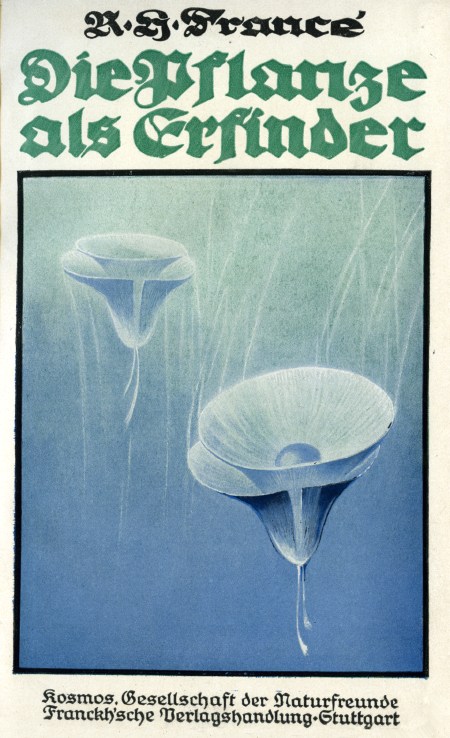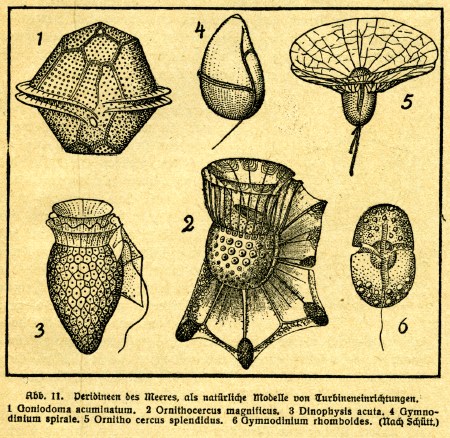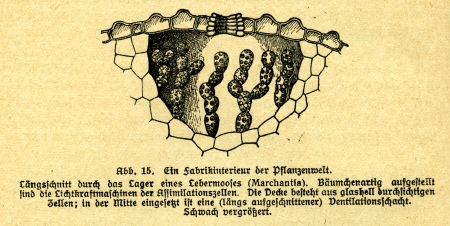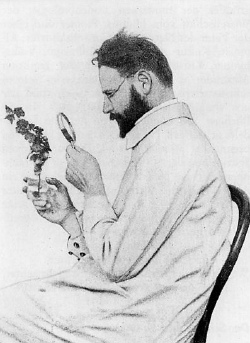
As part of (as always) escalating research for an essay I’m writing I’ve recently been reading this little book: “Die Pflanze als Erfinder” (The Plant as an Inventor), by Raoul Heinrich Francé, Kosmos, Stuttgart, 1920. It is a popular-scientific version of a more hefty volume I haven’t seen yet: “Die Technischen Leistungen der Pflanzen” (The Technical Achievements of Plants), Veit & Cie., Leipzig, 1919.
Because of these two books Francé is regarded as one of the founders of the discipline which is now called “Bionics”, but which he himself called “Biotechnik” (or “Biotechnique” in english). The basic idea behind these books is to look at plants and analyze their ‘solutions’ to technical problems. Raoul Francé has been mostly forgotten now, but in his time he was a great popularizer of biology, a best-selling author and a respected scientist and philosopher. I became interested in him and this little book in particular because of the profound influence it had on artist Laszlo Moholy-Nagy. In many of Moholy’s writings he refers to the “biotechnical elements” or he talks about the “anti-biological” use of modern technology, which are ideas taken from or at least inspired by this little book. Also Moholy-Nagy based an important part of his design philosophy on the ideas contained in it; when he writes about “form follows fuction” he often quotes Francé and in this way gives this phrase a slightly more holistic nuance than some of his other modern collegues would give it.

single-celled organisms interpreted as highly efficient turbines.
Here some notes and quotes about “Die Pflanze als Erfinder”:
One concept which is referred to several times throughout the book is the concept of form as equilibrium, form as the embodiment of a process:
“es gibt für jedes Ding, sei das nun eine sache oder ein Gedanke, gesetzmässig nur eine Form, die allein dem Wesen des Dinges entspricht und die, wenn sie geändert wird, nicht den Ruhezustand, sondern Prozesse auslöst. Diese Prozesse wirken zwangsläufig, nämlich gesetzmässig durch immer wieder einsetzende Zerstörung der Form, bis wieder die optimale, die essentielle Ruheform erreicht ist, in der Form und Wesen wieder eins sind.”
in english:
“for every thing, whether it is an object or a thought, there is only one systematic form that corresponds to the essence of the thing and which, if it is changed does not cause the position of repose, but which causes processes. These processes work compulsively, systematically by the continually renewed disruption of form, until the optimal, essential position of repose has again been reached and form and essence are again one.”

the biotechnical elements by Laszlo Moholy-Nagy
And another important thought which has been quoted several times by Laszlo Moholy-Nagy and which was also a great inspiration to Kurt Schwitters:
“Kristallform, Kugel, Fläche, Stab und Band, Schraube und Kegel, das sind die grundlegenden technischen Formen der ganzen Welt. Sie genügen sämtlichen Vorgängen des gesamten Weltprozesses, um sie zu ihrem Optimum zu geleiten. Alles, was ist, sind wohl Kombinationen dieser sieben Urformen, aber über die heilige Siebenzahl geht es nicht hinaus. Die Natur hat nichts anderes hervorgebracht und der Menschengeist mag schaffen, was er will, er komt immer nur zu Kombinationen und Varianten dieser sieben Grundformen.”
in english:
“Crystalline form, sphere, plane, rod and strip, screw and cone, those are the basic technical shapes of the whole world. These are enough for all events of the whole world process, to lead them to their optimum. All things that exists are combinations of these seven primal forms, but never more than the holy number seven. Nature has produced nothing else, and the human spirit may do whatever it wants, but it will always only result in combinations and variations of these seven basic shapes.”
According to Francé the creativity of nature is far more developed than human creativity:
“In einem derartigen Reichtum hat die Gestaltungskraft der Lebenstoffes jede Möglichkeit verwirklicht, so das jede Künstlerphantasie dagegen nur als stümpernde Kopie erscheint. Man hat das unmittelbar durch den Versuch bewiesen, denn man hat Künstler eine Form für dekorative Zwecke varieren lassen, und sie haben es nur auf wenige Dutzend Varianten unter Zuhilfenahme ihrer ganzen Phantasie gebracht, während in der Welt der Einzeller hunderte fertiger Modelle dafür vorliegen.”
in english:
“The creative force of life-matter has realized every possibillity with so much wealth, that every artists’ phantasy appears as a clumsy copy in comparison. This has been directly proven by an experiment; artists have been asked to make variations on a form for decorative purposes, and with the help of all of their phantasy they could only bring themselves to a few dozen of them, while in the world of single-celled organisms there are hundreds of models readily available.”
At some point Francé mentions Ernst Haeckel’s notion of the “Kunstformen der Natur” (Artforms of Nature) and says that aesthetic appreciation of these beautiful natural forms has little value: the real people to study these forms should be engineers, not artists, since engineers have the mental tools to actually understand these forms and do something with them.

photosynthesis in moss compared to a factory hall.
The middle part of the book is a discussion of what he calls the “Museum of Biotechnique”, with exhibition rooms devoted to flaggelates, algae, cells, leaves, stems and fruit. All of these examples of the ingenuity of nature he compares to human inventions like turbines, building structures, pumps, where he shows how efficient nature’s solutions are and how crude our high technology is in comparison. When he talks about the technical achievements of single-celled organisms he shows how superior they are by scaling them to the size of ocean liners or buildings; Ocean liners for instance that can travel 200 kilometers in 12 seconds…
It is striking that Francé never mentions the different ratio’s between volume and surface at different scales, which is the backbone of d’Arcy Thompson’s book “On Growth and Form”.
“Man gerät mit den nüchternen Zahlen und Berechnungen der Biotechnik immer wieder in eine romanhafte Welt von Möglichkeiten, die vielleicht deshalb der machtigste Ansporn zu weiteren Grosstaten unserer Ingenieure sein wird, weil sie ganz unwidersprechlich beweist, wie weit entfernt unsere Maschinen von der mögliche Lösung der Probleme sind, deren Lösung sie darstellen sollen, trotzdem wir überall auf den richtigen Wegen gehen. Wir beschreiten sie zwar nur deshalb, weil es eben überhaupt nur einen einzigen richtigen Weg gibt und eine Erfindung eben so lange nicht gebrauchsfertig ist, bis nicht der Weg des Naturgesetzes beschritten wird.”
in english:
“Again and again, with the plain numbers and calculations of biotechnique, we reach a fantastic world of possibillities. Perhaps this will be the biggest incentive for further great feats by our engineers, because it irrefutably proves how far our machines are still removed from the possible solution of the problems; solutions they should [still] come up with, even though everywhere we are going along the right road. But we are going along it only because there is only one right road, and an invention will not be ready for practical use as long as the road of the natural law has not yet been treaded.”
and a concluding remark:
“Was haben wir in jener Stunde erkannt ? Dass die Welt ein Ganzes sei, dessen Teile sich gegenseitig beeinflussen. … Der Ausgleich und Harmonie mit den anderen allein kann unser, kann jedes dinges Optimum sein. Und um den Ausgleich zu erreichen, dreht sich das ungeheure, gespenstische Rad des Weltprozesses.”
“[Die Biotechnik] ist für die Dinge eine Befreiung vond der hemmungen, eine Erlösung, eine Erfüllung des Weltensinnes, der nach der Ruhe der vollendeten harmonie strebt. So ist Technik der Weltprozess selbst und zugleich sein Mittel, um sich zu beenden.”
in english:
“What have we now learned ? That the world is one whole, whose parts influence eachother. … Only levelling and harmony with the other can be our optimum, or that of any thing. It is in order to reach this levelling that the monstrous, ghostly wheel of the world process is turning.”
“For the things [biotechnique] is a liberation from restraints, a deliverance, a realization of the world-meaning, which strives towards repose and complete harmony. In this way technique is the world process itself, and at the same time its means to end itself.”
and the final words of the book:
“Die Weltmechanik arbeitet in den Maschinen, mögen sie von den anderen Lebendigen oder von uns aus den technischen Urformen erbaut sein. Wir erbauen sie auch aus Steinen und sprechen dann von Architektur, sie verwirklichen wir auch in Tönen und schaffen klingende Organismen, Kompositionen. Wir errichten ein Abbild der Weltmechanik aus Menschenrechten und Pflichten und nennen es Staat. Oder aus begriffen und sagen dann Philosophie dazu. Stets verwirklichen wir damit nur unserer Lebens Gesetz, wir tragen die Lebensgesetzlichkeit damit in alle unsere Werke, in unser ganzes Weltbild.”
“Die Menschheit schafft sich zuerst aus ihren Gesetzen ein Sinnenbild der Natur und eine ganze Kulturwelt und preist dann den als grossen Entdecker eines unerhört Neuen, der diese Gesetze in der Welt wieder aufdeckt. Sie merkt es nicht, dass der Weltprozess selbst den Menschen dazu zwingt, denn Leben wird alles nach dem Lebensgesetz einrichten. Darum ist alle Wahrheit ein Kreis, alles Wissen relativ und die Erkenntnis eine Schlange, die sich selbst in den Schwanz beisst.”
in english:
“The mechanics of the world are at work in the machines, may they have been built by either the other living creatures or by us out of the technical primal forms. We also build them out of stones and then speak of architecture, they realize themselves in tones and form sounding organisms, compositions. We erect an image of the world mechanics out of human rights and duties and call it a state. Or from concepts and then call it philosophy. All the time we are only realizing our law of life, we carry this law-of-life-ness with us in all our products, in our whole world view.”
“Mankind first creates out of its laws a symbol of nature and a whole world of culture, and then praises as a great discoverer of something incredibly new the person who again brings out these laws in the world. Mankind doesn’t realize that the world process itself forces man to do so, because life will always arrange everything according to the law of life. That is why all truth is a circle, all knowing is relative and all knowledge a snake that bites its own tail.”

Raoul Francé in 1899
The flip-side of all this interesting stuff came to my attention when I read this essay on the roots of ‘Ecofascism’, which mentions Francé (and especially Ernst Haeckel, who used to be another one of my heroes because of his amazing book “Kunstformen der Natur“). To check this I read some parts of Francé’s magnum opus “Bios, die Gesetze der Welt” (Bios, the laws of the world), and I quote the most depressing bit here, from a passage where he talks about social insects (from Band 1, page 225):
“Wo wir das Optimum des Staatenlebens angenähert finden – und bei sozialen Insekten ist es unbestritten angenähert -, da wurde es nur erreicht, dadurch dass der Staat keine rassefremden Eindringlinge duldete. Jede Ameise aus fremden Nest wird unerbittlich getötet oder versklavt, so wie die Ameisengäste aus dem Kreise der Käfer und dergl. In den von Krisen freien und dauernd haltbaaren Staaten – die sozialen Insekten befolgen dieses System mindestens seit dem Tertiär, also seit annähernd zweitausendmal längerer Zeit als es Mensschenstaaten gibt – ist demnach Rassenhygiene und die Hochhaltung der Reinrassigkeit eine streng gewahrte Vorbedingung des Staatenbildung.”
in english:
“Whereever we find an approximation of the optimum of the life of the state (and in social insects this optimum is undoubtedly approximated) this has only been possible because the state did not tolerate any intruder foreign to the race. Every ant from a foreign nest will without mercy be killed or enslaved, just like the visitors from the circles of beetles etc. Consequently, in the states which are able to preserve themselves for a long time (and the social insects follow this system at least since the Tertiary, that is since almost twothousand times longer than there are human states) racial hygiene and the preservation of the racial purity are preconditions which are strictly observed.”
and a bit later, after proposing the introduction of “Rassenpolitik” (“Racial Policy”):
“Man fühlt es, wie man mit diesen Gedanken an die Wurzeln des Elendes greift, das die Menschheit quält.”
in english:
“We can feel how, with these thoughts, we touh at the roots of the misery that plagues mankind.”
Right, that did make me feel miserable for a couple of days indeed. I don’t know what Francé did during the second world war, before he died in Budapest in 1943, so I don’t know whether he was actually supportive of the Nazi’s. I did read that in 1919 his lab in München was destroyed as part of a failed communist revolution attempt, so he must have represented something to these revolutionaries already then. I suppose Moholy-Nagy was not aware of Francé’s political ideas, since he quotes Francé in all of his major writings, including “Vision in Motion”. When Moholy-Nagy refers to “biological needs”, he does so mostly when he is advocating more attention for the social dimensions of technological progress, as part of a decidedly left-wing agenda, to remind artists of their responsabilities and role in society. So to end on a more positive note here one of my favourite utopic quotes by Laszlo Moholy-Nagy:
“The photogram for the first time produces space without existing space structure, only by articulation on the plane with the advancing and receding values of half-tones in black and gray and with the radiating power of their contrasts and their sublime gradations. One suddenly becomes aware that there starts an invigorating investigation about the incoherent use of our rich resources. Technological ingenuity provides us with gigantic structures, factories and skyscrapers, but how we use them is shockingly anti-biological – resulting in wild city growth, elimination of vegetation, fresh air and sunlight. To make bad worse, in the shadow of these modern buildings we thoughtlessly tolerate the slums and every bad condition that goes with them. So it seems that the most abstract experiment of space-time articulation carries a sensible reality, if the right interpretation can be made. Such experiments may signalize a spatial order in which not single structural parts, or large spans of openings will play the important part, but the relationship of neighbour units, buildings and free areas, shelter and leisure, production and recreation; leading toward a biologically right living most probably through a right regional planning; toward a city-land unity.”
(L.Moholy-Nagy, ‘Space-Time and the Photographer’, American Annual of Photography, 1942)
